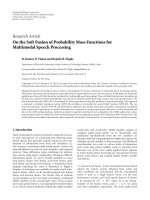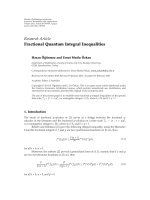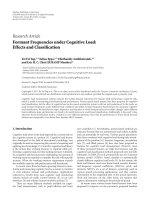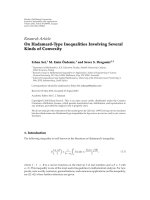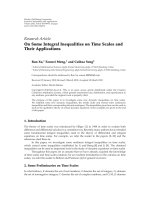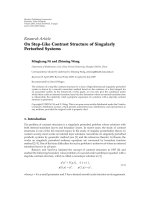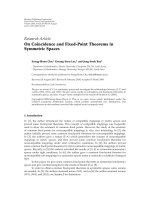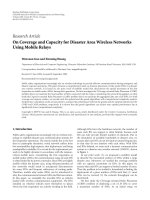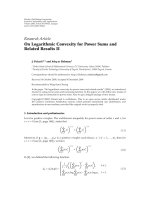Báo cáo hóa học: " Research Article On Opial-Type Integral Inequalities Wing-Sum Cheung and Chang-Jian Zhao" doc
Bạn đang xem bản rút gọn của tài liệu. Xem và tải ngay bản đầy đủ của tài liệu tại đây (546.15 KB, 15 trang )
Hindawi Publishing Corporation
Journal of Inequalities and Applications
Volume 2007, Article ID 38347, 15 pages
doi:10.1155/2007/38347
Research Article
On Opial-Type Integral Inequalities
Wing-Sum Cheung and Chang-Jian Zhao
Received 22 January 2007; Accepted 4 April 2007
Recommended by Peter Yu Hin Pang
We establish some new Opial-type inequalities involving functions of two and many in-
dependent variables. Our results in special cases yield some of the recent results on Opial’s
inequality a nd also provide new estimates on inequalities of this type.
Copyright © 2007 W S. Cheung and C J. Zhao. This is an open access article distributed
under the Creative Commons Attribution License, which permits unrestricted use, dis-
tribution, and reproduction in any medium, provided the original work is properly cited.
1. Introduction
In the year 1960, Opial [1] established the following integ ral inequality.
Theorem 1.1. Suppose f
∈ C
1
[0,h] satisfies f (0) = f (h) = 0 and f (x) > 0 for all x ∈
(0,h). Then the integral inequality holds
h
0
f (x) f
(x)
dx ≤
h
4
h
0
f
(x)
2
dx, (1.1)
where this constant h/4 is best possible.
Opial’s inequality and its generalizations, extensions, and discretizations play a fun-
damental role in establishing the existence and uniqueness of initial and boundary value
problems for ordinary and partial differential equations as well as difference equations
[2–6]. The inequality (1.1) has received considerable attention and a large number of pa-
pers dealing with new proofs, extensions, generalizations, variants, and discrete analogs
of Opial’s inequality have appeared in s ome literature [7–22]. For an extensive survey on
these inequalities, see [2, 6]. The main purpose of the present paper is to establish some
new Opial-type inequalities involving functions of two and many independent variables.
Our results in special cases yield some of the recent results on Opial’s inequality and pro-
vide some new estimates on such types of inequalities.
2 Journal of Inequalities and Applications
2. Main results
Our main results are given in the following theorems.
Theorem 2.1. Let u
i
(s,t), v
i
(s,t), i = 1, ,n, be real-valued absolutely continuous f unc-
tions defined on [a, b]
× [c,d] and a,b,c,d ∈ [0,∞) with u
i
(s,c) = u
i
(a,t) = u
i
(a,c) = 0,
v
i
(s,c) = v
i
(a,t) = v
i
(a,c) = 0, i = 1, , n.LetF, G be real-valued nonnegative continuous
and nondecreasing functions on [0,
∞)
n
with F(0, ,0) = 0, G(0, ,0) = 0 such that all
their partial derivatives ∂
2
F/∂|u
i
|
2
, ∂F/∂|u
i
|, ∂
2
G/∂|v
i
|
2
, ∂G/∂|v
i
|, i = 1, ,n are nonneg-
ative continuous and nondecreasing functions on [0,
∞)
n
.Let∂|u
i
|/∂s, ∂|u
i
|/∂t, ∂
2
|u
i
|/∂s∂t,
∂
|v
i
|/∂s, ∂|v
i
|/∂t, ∂
2
|v
i
|/∂s∂t, i = 1, ,n, be nonnegative continuous and nondecreasing
functions on [a,b]
× [c,d]. Then
b
a
d
c
F
u
1
(s,t)
, ,
u
n
(s,t)
n
i=1
∂
2
G
∂
v
i
2
·
∂
v
i
∂t
·
∂
v
i
∂s
+
∂G
∂
v
i
·
∂|v
i
|
∂s∂t
+ G
v
1
(s,t)
, ,
v
n
(s,t)
n
i=1
∂
2
F
∂
u
i
2
·
∂
u
i
∂t
·
∂
u
i
∂s
+
∂F
∂
u
i
·
∂
u
i
∂s∂t
+ S(s,t)
dsdt
≤ F
b
a
d
c
∂
2
u
1
∂s∂t
dsdt, ,
b
a
d
c
∂
2
u
n
∂s∂t
dsdt
·
G
b
a
d
c
∂
2
v
1
∂s∂t
dsdt, ,
b
a
d
c
∂
2
v
n
∂s∂t
dsdt
,
(2.1)
where
S(s,t)
=
n
i=1
∂F
∂
u
i
∂
u
i
∂s
·
n
i=1
∂G
∂
v
i
∂
v
i
∂t
+
n
i=1
∂F
∂
u
i
∂
u
i
∂t
·
n
i=1
∂G
∂
v
i
∂
v
i
∂s
. (2.2)
Proof. From the hypotheses on u
i
(s,t), v
i
(s,t), i = 1, ,n,wehave
u
i
(s,t)
≤
s
a
t
c
∂
2
u
i
∂σ∂τ
(σ,τ)
dσdτ,
v
i
(s,t)
≤
s
a
t
c
∂
2
v
i
∂σ∂τ
(σ,τ)
dσdτ,
(2.3)
for s
∈ [a,b], t ∈ [c, d].
W S. Cheung and C J. Zhao 3
From (2.3) and in view of the hypotheses on all partial der ivatives, and by letting
U
i
(s,t) =
s
a
t
c
∂
2
u
i
∂σ∂τ
(σ,τ)
dσdτ,
V
i
(s,t) =
s
a
t
c
∂
2
v
i
∂σ∂τ
(σ,τ)
dσdτ,
(2.4)
we obtain
b
a
d
c
F
u
1
(s,t)
, ,
u
n
(s,t)
n
i=1
∂
2
G
∂
v
i
2
·
∂
v
i
∂t
·
∂
v
i
∂s
+
∂G
∂
v
i
·
∂
2
v
i
∂s∂t
+ G
v
1
(s,t)
, ,
v
n
(s,t)
n
i=1
∂
2
F
∂
u
i
2
·
∂
u
i
∂t
·
∂
u
i
∂s
+
∂F
∂
u
i
·
∂
2
u
i
∂s∂t
+
n
i=1
∂F
∂
u
i
·
∂
u
i
∂s
·
n
i=1
∂G
∂
v
i
·
∂
v
i
∂t
+
n
i=1
∂F
∂
u
i
·
∂
u
i
∂t
·
n
i=1
∂G
∂
v
i
·
∂
v
i
∂s
dsdt
≤
b
a
d
c
F
U
1
(s,t), ,U
n
(s,t)
·
n
i=1
∂
2
G
∂V
2
i
·
∂V
i
∂t
·
∂V
i
∂s
+
∂G
∂V
i
·
∂
2
V
i
∂s∂t
+ G
V
1
(s,t), ,V
n
(s,t)
·
n
i=1
∂
2
F
∂U
2
i
·
∂U
i
∂t
·
∂U
i
∂s
+
∂F
∂U
i
·
∂
2
U
i
∂s∂t
+
n
i=1
∂F
∂U
i
∂U
i
∂s
·
n
i=1
∂G
∂V
i
∂V
i
∂t
+
n
i=1
∂F
∂U
i
∂U
i
∂t
·
n
i=1
∂G
∂V
i
∂V
i
∂s
dsdt
=
b
a
d
c
∂
2
∂s∂t
F
U
1
(s,t), ,U
n
(s,t)
·
G
V
1
(s,t), ,V
n
(s,t)
dsdt
= F
U
1
(b,d), ,U
n
(b,d)
·
G
V
1
(b,d), ,V
n
(b,d)
=
F
b
a
d
c
∂
2
u
1
∂s∂t
dsdt, ,
b
a
d
c
∂
2
u
n
∂s∂t
dsdt
·
G
b
a
d
c
∂
2
v
1
∂s∂t
dsdt, ,
b
a
d
c
∂
2
v
n
∂s∂t
dsdt
.
(2.5)
This completes t he proof of inequality (2.1).
4 Journal of Inequalities and Applications
Remark 2.2. (i) Taking G
= 1 in inequality (2.1), and in view of
∂
2
G
∂
v
i
2
·
∂
v
i
∂t
·
∂
v
i
∂s
+
∂G
∂
v
i
∂
v
i
∂s∂t
= 0, S(s,t) = 0, (2.6)
for i
= 1, ,n,wehave
b
a
d
c
n
i=1
∂
2
F
∂
u
i
2
·
∂
u
i
∂t
·
∂
u
i
∂s
+
∂F
∂
u
i
·
∂
2
u
i
∂s∂t
dsdt
≤ F
b
a
d
c
∂
2
u
1
∂s∂t
dsdt, ,
b
a
d
c
∂
2
u
n
∂s∂t
dsdt
,
(2.7)
for i
= 1, ,n.
Let u
i
(s,t)reducetou
i
(t), where i = 1, ,n and with suitable modifications, then (2.7)
becomes the following inequality:
b
a
n
i=1
F
i
u
1
(t)
, ,
u
n
(t)
u
i
(t)
dt ≤ F
b
a
u
1
(t)
dt, ,
b
a
u
n
(t)
dt
.
(2.8)
This is a recent inequality which was given by Pe
ˇ
cari
´
c and Brneti
´
c[18, 19].
Taking n
= 1, inequality (2.7)reducesto
b
a
d
c
∂
2
F
∂|u|
2
·
∂|u|
∂t
·
∂|u|
∂s
+
∂F
∂|u|
·
∂
2
|u|
∂s∂t
dsdt ≤ F
b
a
d
c
∂
2
u
∂s∂t
dsdt
. (2.9)
Let u(s,t)reducetou(t) and with suitable modifications, then the above inequality
becomes the following inequality:
b
a
F
f (t)
f
(t)
dt ≤ F
b
a
f
(x)
dt
. (2.10)
This is an inequalit y which was given by Godunova and Levin [12].
(ii) Taking G
= F and u
i
(s,t) = v
i
(s,t), i = 1, ,n, in inequality (2.1), we have
b
a
d
c
F
u
1
(s,t)
, ,
u
n
(s,t)
n
i=1
∂
2
G
∂
u
i
2
·
∂
u
i
∂t
·
∂
u
i
∂s
+
∂G
∂
u
i
∂
u
i
∂s∂t
+
n
i=1
∂F
∂u
i
∂u
i
∂s
·
n
i=1
∂F
∂u
i
∂u
i
∂t
dsdt
≤
1
2
· F
2
b
a
d
c
∂
2
u
1
∂s∂t
dsdt, ,
b
a
d
c
∂
2
u
n
∂s∂t
dsdt
.
(2.11)
W S. Cheung and C J. Zhao 5
Taking n
= 1, (2.11)reducesto
b
a
d
c
F
u(s,t)
∂
2
G
∂|u|
2
·
∂|u|
∂t
·
∂|u|
∂s
+
∂G
∂|u|
∂|u|
∂s∂t
+
∂F
∂u
∂u
∂s
∂F
∂u
∂u
∂t
dsdt
≤
1
2
· F
2
b
a
d
c
∂
2
u
∂s∂t
dsdt
.
(2.12)
Let u(s,t)reducetou(t) and with suitable modifications, then (2.12) becomes the
following inequality:
b
a
F
u(t)
·
F
u(t)
·
u
(t)
dt ≤
1
2
F
2
b
a
u
(t)
dt
. (2.13)
This is an inequality given by Pachpatte in [15].
Inequality (2.12) is also a similar form of the following inequality which was given by
Yan g [22]:
b
1
a
1
b
2
a
2
f
t
1
,t
2
∂
2
f
∂t
1
∂t
2
dt
1
dt
2
≤
b
1
− a
1
b
2
− a
2
8
b
1
a
1
b
2
a
2
∂
2
f
∂t
1
∂t
2
t
1
,t
2
2
dt
1
dt
2
.
(2.14)
(iii) Let u
i
(s,t)andv
i
(s,t)reducetou
i
(s)andv
i
(s), respectively, and with suitable mod-
ifications (where i
= 1, ,n), then inequality (2.1) changes to the following inequality:
b
a
F
u
1
(t)
, ,
u
n
(t)
n
i=1
G
i
v
1
(t)
, ,
v
n
(t)
v
i
(t)
+ G
v
1
(t)
, ,
v
n
(t)
n
i=1
F
i
u
1
(t)
, ,
u
n
(t)
u
i
(t)
dt
≤ F
b
a
u
1
(t)
dt, ,
b
a
u
n
(t)
dt
·
G
b
a
u
1
(t)
dt, ,
b
a
u
n
(t)
dt
.
(2.15)
This is an inequality given by Agarwal and Pang in [2].
Taking n
= 1, G = 1, F(u) = u
2
,(2.15) changes to
b
a
u(t)
u
(t)
dt ≤
1
2
(b
− a)
b
a
u
(t)
2
dt. (2.16)
This is another version of the Opial’s inequality, (see [13]).
(iv) Taking G
= 1, F = (|u
1
|, ,|u
n
|) =
n
i
=1
f
i
(|u
i
|), i = 1, ,n,in(2.1), (2.1) changes
to a general form of the inequality which was given by Pachpatte [16], where the functions
f
i
must satisfy some suitable conditions, (see [16]).
6 Journal of Inequalities and Applications
Theorem 2.3. Let u
i
(s,t), v
i
(s,t), F, G, ∂
2
F/∂|u
i
|
2
, ∂F/∂|u
i
|, ∂|u
i
|/∂s, ∂|u
i
|/∂t, ∂
2
|u
i
|/∂s∂t,
∂
2
G/∂|v
i
|
2
, ∂G/∂|v
i
|, ∂|v
i
|/∂s, ∂|v
i
|/∂t, ∂
2
|v
i
|/∂s∂t, i = 1, ,n,beasinTheorem 2.1.Let
p
i
(s,t), q
i
(s,t), i = 1, ,n, be real-valued positive functions defined on [a,b] × [c,d] satis-
fy ing
b
a
d
c
p
i
(s,t)dsdt = 1,
b
a
d
c
q
i
(s,t)dsdt = 1(i = 1, ,n). (2.17)
Let h
i
, w
i
, i = 1, ,n, be real-valued positive convex and increasing functions on (0,∞)
2
.
Then the following integral inequality holds:
b
a
d
c
F
u
1
(s,t)
, ,
u
n
(s,t)
n
i=1
∂
2
G
∂
v
i
2
·
∂
v
i
∂t
·
∂
v
i
∂s
+
∂G
∂
v
i
∂
2
v
i
∂s∂t
+ G
v
1
(s,t)
, ,
v
n
(s,t)
n
i=1
∂
2
F
∂
u
i
2
·
∂
u
i
∂t
·
∂
u
i
∂s
+
∂F
∂
u
i
∂
2
u
i
∂s∂t
+ S(s,t)
dsdt
≤ F
h
−1
1
b
a
d
c
p
1
(s,t)h
1
∂
2
u
1
/∂s∂t
p
1
(s,t)
dsdt
, ,
h
−1
n
b
a
d
c
p
n
(s,t)h
n
∂
2
u
n
/∂s∂t
p
n
(s,t)
dsdt
·
G
w
−1
1
b
a
d
c
q
1
(s,t)w
1
∂
2
v
1
/∂s∂t
q
1
(s,t)
dsdt
, ,
w
−1
n
b
a
d
c
q
n
(s,t)w
n
∂
2
v
n
/∂s∂t
q
n
(s,t)
dsdt
,
(2.18)
where
S(s,t) =
n
i=1
∂F
∂
u
i
∂
u
i
∂s
·
n
i=1
∂G
∂
v
i
∂
v
i
∂t
+
n
i=1
∂F
∂
u
i
∂
u
i
∂t
·
n
i=1
∂G
∂
v
i
∂
v
i
∂s
.
(2.19)
Proof. From the hypotheses, we h ave
b
a
d
c
∂u
2
i
∂s∂t
dsdt =
b
a
d
c
p
i
(s,t)
∂u
2
i
/∂s∂t
p
i
(s,t)dsdt
b
a
d
c
p
i
(s,t)dsdt
,
b
a
d
c
∂v
2
i
∂s∂t
dsdt =
b
a
d
c
q
i
(s,t)
∂v
2
i
/∂s∂t|
q
i
(s,t)dsdt
b
a
d
c
q
i
(s,t)dsdt
,
(2.20)
for i
= 1, ,n.
W S. Cheung and C J. Zhao 7
From (2.20), the hypotheses on h
i
, w
i
, i = 1, ,n, and in view of Jensen’s inequality,
we obtain
h
i
b
a
d
c
∂u
2
i
∂s∂t
dsdt
≤
b
a
d
c
p
i
(s,t) · h
i
∂
2
u
i
/∂s∂t
p
i
(s,t)
dsdt,
w
i
b
a
d
c
∂v
2
i
∂s∂t
dsdt
≤
b
a
d
c
q
i
(s,t) · w
i
∂
2
v
i
/∂s∂t
q
i
(s,t)
dsdt,
(2.21)
for i
= 1, ,n.
From (2.21), we observe t hat
b
a
d
c
∂u
2
i
∂s∂t
dsdt ≤ h
(i)
−1
b
a
d
c
p
i
(s,t) · h
i
∂
2
u
i
/∂s∂t
p
i
(s,t)
dsdt
,
b
a
d
c
∂v
2
i
∂s∂t
dsdt ≤ w
(i)
−1
b
a
d
c
q
i
(s,t) · w
i
∂
2
v
i
/∂s∂t
q
i
(s,t)
dsdt
,
(2.22)
for i
= 1, ,n.
From (2.22) and in view of inequality (2.1), we get inequality (2.18) and the proof is
complete.
Remark 2.4. (i) Taking G = 1 in inequality (2.18), and in view of
∂
2
G
∂
v
i
2
·
∂
v
i
∂t
·
∂
v
i
∂s
+
∂G
∂
v
i
∂
v
i
∂s∂t
= 0, (2.23)
for i
= 1, ,n,and
S(s,t)
= 0, (2.24)
(2.18)becomes
b
a
d
c
n
i=1
∂
2
F
∂
u
i
2
·
∂
u
i
∂t
·
∂
u
i
∂s
+
∂F
∂
u
i
·
∂
2
u
i
∂s∂t
dsdt
≤ F
h
−1
1
b
a
d
c
p
1
(s,t)h
1
∂
2
u
1
/∂s∂t
p
1
(s,t)
dsdt
, ,
h
−1
n
b
a
d
c
p
n
(s,t)h
n
∂
2
u
n
/∂s∂t
p
n
(s,t)
dsdt
,
(2.25)
for i
= 1, ,n.
8 Journal of Inequalities and Applications
Let u
i
(s,t), h
i
(s,t), and p
i
(s,t)changeto f
i
(t), h
i
(t), and p
i
(t), respectively, where i =
1, ,n,then(2.25) reduces to the following inequality:
b
a
n
i=1
D
i
F
f
1
(t)
, ,
f
n
(t)
f
i
(t)
dt
≤ F
h
−1
1
b
a
p
1
(t)h
1
f
1
(t)
p
1
(t)
dt
, ,h
−1
n
b
a
p
n
(t)h
n
f
n
(t)
p
n
(t)
dt
,
(2.26)
where D
i
F is as in [18]. This is an inequality given by Pe
ˇ
cari
´
cin[18].
Taking F(x
1
, ,x
n
) =
n
i
=1
F
i
(x
i
), i = 1, ,n,(2.25) changes to a general form of the
inequality which was given by Pachpatte [16]. Taking n
= 1, (2.25) reduces to a general
form of the inequality which was given by Godunova and Levin [12].
On the other hand, inequality (2.18) is also a general form of another inequality in
Pe
ˇ
cari
´
c and Brneti
´
c[20,Theorem1].
(ii) Taking G
= F and u
i
(s,t) = v
i
(s,t), i = 1, ,n, in inequality (2.18), we have
b
a
d
c
F
u
1
(s,t)
, ,
u
n
(s,t)
n
i=1
∂
2
G
∂
u
i
2
·
∂
u
i
∂t
·
∂
u
i
∂s
+
∂G
∂
u
i
∂
u
i
∂s∂t
+
n
i=1
∂F
∂u
i
∂u
i
∂s
·
n
i=1
∂F
∂u
i
∂u
i
∂t
dsdt
≤
1
2
· F
2
h
−1
1
b
a
d
c
p
1
(s,t)h
1
∂
2
u
1
/∂s∂t
p
1
(s,t)
dsdt
, ,
h
−1
n
b
a
d
c
p
n
(s,t)h
n
∂
2
u
n
/∂s∂t
p
n
(s,t)
dsdt
.
(2.27)
Taking n
= 1, (2.27)reducesto
b
a
d
c
F
u(s,t)
∂
2
G
∂|u|
2
·
∂|u|
∂t
·
∂|u|
∂s
+
∂G
∂|u|
∂|u|
∂s∂t
+
∂F
∂u
∂u
∂s
∂F
∂u
∂u
∂t
dsdt
≤
1
2
· F
2
h
−1
b
a
d
c
p(s,t)h
∂
2
u/∂s∂t
p(s,t)
dsdt
.
(2.28)
This is a general form of the inequality which was given by Pachpatte [14].
(iii) Let u
i
(s,t), v
i
(s,t), h
i
(s,t), w
i
(s,t), p
i
(s,t), and q
i
(s,t)reducetou
i
(t), v
i
(t), h
i
(t),
w
i
(t), p
i
(t), and q
i
(t), respectively, and with suitable modifications (where i = 1, , n),
W S. Cheung and C J. Zhao 9
then inequality (2.18) changes to the following inequality:
b
a
F
u
1
(t)
, ,
u
n
(t)
n
i=1
G
i
v
1
(t)
, ,
v
n
(t)
v
i
(t)
+ G
v
1
(t)
, ,
v
n
(t)
n
i=1
F
i
u
1
(t)
, ,
u
n
(t)
u
i
(t)
dt
≤ F
h
−1
1
b
a
p
1
(t)h
1
u
1
(t)
p
1
(t)
dt
, ,h
−1
n
b
a
p
n
(t)h
n
u
n
(t)
p
n
(t)
dt
·
G
w
−1
1
b
a
q
1
(t)w
1
v
1
(t)
q
1
(t)
dt
, ,w
−1
n
b
a
q
n
(t)w
n
v
n
(t)
q
n
(t)
dt
.
(2.29)
This is just an inequality given by Agarwal and Pang in [2].
Theorem 2.5. Let u
i
(s,t), v
i
(s,t), F, G,beasinTheorem 2.1.Letφ
i
, ψ
i
, i = 1, ,n, be real-
valued positive convex and increasing functions on (0,
∞)
2
.Letr
i
(s,t) ≥ 0, ∂
2
r
i
/∂s∂t > 0,
r
i
(s,c) = r
i
(a,t) = r
i
(a,c) = 0, ∂
2
e
i
/∂s∂t > 0, e
i
(s,c) = e
i
(a,t) = e
i
(a,c) = 0, i = 1, ,n.Let
∂
2
F/∂M
2
i
, ∂F/∂M
i
, ∂
2
G/∂N
2
i
, ∂G/∂N
i
, i = 1, ,n, be nonnegative continuous and nonde-
creasing functions on [0,
∞)
n
.Let∂M
i
/∂s, ∂M
i
/∂t, ∂
2
M
i
/∂s∂t, ∂N
i
∂s, ∂N
i
/∂t, ∂
2
N
i
/∂s∂t,
i
= 1, ,n, be nonnegative continuous and nondecreasing functions on [a,b] × [c,d]. Then
the following inequality holds:
b
a
d
c
F
M
1
(s,t), ,M
n
(s,t)
·
n
i=1
∂
2
G
∂N
2
i
·
∂N
i
∂t
·
∂N
i
∂s
+
∂G
∂N
i
·
∂
2
N
i
∂s∂t
+G
N
1
(s,t), ,N
n
(s,t)
·
n
i=1
∂
2
F
∂M
2
i
·
∂M
i
∂t
·
∂M
i
∂s
+
∂F
∂M
i
·
∂
2
M
i
∂s∂t
+S(s,t)
dsdt
≤ F
b
a
d
c
∂
2
r
1
∂s∂t
·φ
1
∂
2
u
1
/∂s∂t
∂
2
r
1
/∂s∂t
dsdt, ,
b
a
d
c
∂
2
r
n
∂s∂t
·φ
n
∂
2
u
n
/∂s∂t
∂
2
r
n
/∂s∂t
dsdt
·
G
b
a
d
c
∂
2
e
1
∂s∂t
·ψ
1
∂
2
v
1
/∂s∂t
∂
2
e
1
/∂s∂t
dsdt, ,
b
a
d
c
∂
2
e
n
∂s∂t
·ψ
n
∂
2
v
n
/∂s∂t
∂
2
e
n
/∂s∂t
dsdt
,
(2.30)
where
M
i
(s,t) = r
i
(s,t) · φ
i
u
i
(s,t)
r
i
(s,t)
,
N
i
(s,t) = e
i
(s,t) · ψ
i
v
i
(s,t)
e
i
(s,t)
,
(2.31)
10 Journal of Inequalities and Applications
for i
= 1, ,n,and
S(s,t) =
n
i=1
∂F
∂M
i
∂M
i
∂s
·
n
i=1
∂G
∂N
i
∂N
i
∂t
+
n
i=1
∂F
∂M
i
∂M
i
∂t
·
n
i=1
∂G
∂N
i
∂N
i
∂s
, (2.32)
for i
= 1, ,n.
Proof. From the hypotheses on u
i
(s,t), v
i
(s,t), r
i
(s,t), e
i
(s,t), i = 1, ,n,wehave
u
i
(s,t)
≤
s
a
t
c
∂
2
u
i
∂σ∂τ
(σ,τ)
dσdτ,
v
i
(s,t)
≤
s
a
t
c
∂
2
v
i
∂σ∂τ
(σ,τ)
dσdτ,
r
i
(s,t) =
s
a
t
c
∂
2
r
i
∂σ∂τ
(σ,τ)dσdτ,
e
i
(s,t) =
s
a
t
c
∂
2
e
i
∂σ∂τ
(σ,τ)dσdτ,
(2.33)
for s
∈ [a,b], t ∈ [c, d].
From (2.33) and using the hypotheses on φ
i
, ψ
i
, i = 1, ,n, and Jensen’s inequality, we
have
M
i
(s,t) ≤
s
a
t
c
∂
2
r
i
∂σ∂τ
· φ
i
∂
2
u
i
/∂σ∂τ
(σ,τ)
∂
2
r
i
/∂σ∂τ
(σ,τ)
dσdτ,
N
i
(s,t) ≤
s
a
t
c
∂
2
e
i
∂σ∂τ
· ψ
i
∂
2
v
i
/∂σ∂τ
(σ,τ)
∂
2
e
i
/∂σ∂τ
(σ,τ)
dσdτ,
(2.34)
for s
∈ [a,b], t ∈ [c, d].
From (2.34), using the hopytheses on al l partial der ivatives and in view of
M
i
(s,t) =
s
a
t
c
∂
2
r
i
∂σ∂τ
· φ
i
∂
2
u
i
/∂σ∂τ
∂
2
r
i
/∂σ∂τ
dσdτ,
N
i
(s,t) =
s
a
t
c
∂
2
e
i
∂σ∂τ
· ψ
i
∂
2
v
i
/∂σ∂τ
∂
2
e
i
/∂σ∂τ
dσdτ,
(2.35)
W S. Cheung and C J. Zhao 11
we hav e
b
a
d
c
F
M
1
(s,t), ,M
n
(s,t)
·
n
i=1
∂
2
G
∂N
2
i
·
∂N
i
∂t
·
∂N
i
∂s
+
∂G
∂N
i
·
∂
2
N
i
∂s∂t
+ G
N
1
(s,t), ,N
n
(s,t)
·
n
i=1
∂
2
F
∂M
2
i
·
∂M
i
∂t
·
∂M
i
∂s
+
∂F
∂M
i
·
∂
2
M
i
∂s∂t
+ S(s,t)
dsdt
≤
b
a
d
c
F
M
1
(s,t), ,M
n
(s,t)
·
n
i=1
∂
2
G
∂N
2
i
·
∂N
i
∂t
·
∂N
i
∂s
+
∂G
∂N
i
·
∂
2
N
i
∂s∂t
+ G
N
1
(s,t), ,N
n
(s,t)
·
n
i=1
∂
2
F
∂M
2
i
·
∂M
i
∂t
·
∂M
i
∂s
+
∂F
∂M
i
·
∂
2
M
i
∂s∂t
+
n
i=1
∂F
∂M
i
∂M
i
∂s
·
n
i=1
∂G
∂N
i
∂N
i
∂t
+
n
i=1
∂F
∂M
i
∂M
i
∂t
·
n
i=1
∂G
∂N
i
∂N
i
∂s
dsdt
=
b
a
d
c
∂
2
∂s∂t
F
M
1
(s,t), ,M
n
(s,t)
·
G
N
1
(s,t), ,N
n
(s,t)
dsdt
= F
M
1
(b,d), ,M
n
(b,d)
·
G
N
1
(b,d), ,N
n
(b,d)
=
F
b
a
d
c
∂
2
r
1
∂s∂t
· φ
1
∂
2
u
1
/∂s∂t
∂
2
r
1
/∂s∂t
dsdt, ,
b
a
d
c
∂
2
r
n
∂s∂t
· φ
n
∂
2
u
n
/∂s∂t
∂
2
r
n
/∂s∂t
dsdt
·
G
b
a
d
c
∂
2
e
1
∂s∂t
·ψ
1
∂
2
v
1
/∂s∂t
∂
2
e
1
/∂s∂t
dsdt, ,
b
a
d
c
∂
2
e
n
∂s∂t
· ψ
n
∂
2
v
n
/∂s∂t
∂
2
e
n
/∂s∂t
dsdt
.
(2.36)
This completes the proof.
Remark 2.6. (i) Taking n = 1, (2.30) changes to a general form of the inequality which
was given by Pachpatte [17].
(ii) Taking G
= 1, (2.30) changes to a general form of the inequality which was given
by Pe
ˇ
cari
´
c and Brneti
´
c[19].
(iii) Taking n
= 1, G = 1, (2.30) changes to the following inequalit y:
b
a
d
c
∂
2
F
∂M
2
·
∂M
∂t
·
∂M
∂s
+
∂F
∂M
·
∂
2
M
∂s∂t
dsdt ≤ F
b
a
d
c
∂
2
r
∂s∂t
· φ
∂
2
u/∂s∂t
∂
2
r/∂s∂t
dsdt
,
(2.37)
which is a general form of the follw ing inequality established by Rozanova [21]:
b
a
F
r(t)φ
f (t)
r(t)
r
(t)φ
f
(t)
r
(t)
dt ≤ F
b
a
r
(t)φ
f
(x)
r
(t)
dt
. (2.38)
12 Journal of Inequalities and Applications
(iv) Let u
i
(s,t), v
i
(s,t), r
i
(s,t), and e
i
(s,t)reducetou
i
(t), v
i
(t), r
i
(t), and e
i
(t), respec-
tively, and w ith suitable modifications (where i
= 1, ,n), the inequality in Theorem 2.5
changes to the inequality in Agarwal and Pang [2, Theorem 3, page 305].
Theorem 2.7. Let u
i
(s,t), v
i
(s,t), F, G,beasinTheorem 2.1.Letp
i
, q
i
, h
i
, w
i
, i = 1, ,n,
be as in Theorem 2.3.Let
S(s,t), M
i
, N
i
, ∂
2
F/∂M
2
i
, ∂F/∂M
i
, ∂
2
G/∂N
2
i
, ∂G/∂N
i
, i = 1, ,n,
∂
M
i
/∂s, ∂M
i
/∂t, ∂
2
M
i
/∂s∂t, ∂N
i
/∂s, ∂N
i
/∂t, ∂
2
N
i
/∂s∂t, i = 1, , n,beasinTheorem 2.5.
Then the following integral inequality holds:
b
a
d
c
F
M
1
(s,t), ,M
n
(s,t)
·
n
i=1
∂
2
G
∂N
2
i
·
∂N
i
∂t
·
∂N
i
∂s
+
∂G
∂N
i
·
∂
2
N
i
∂s∂t
+ G
N
1
(s,t), ,N
n
(s,t)
·
n
i=1
∂
2
F
∂M
2
i
·
∂M
i
∂t
·
∂M
i
∂s
+
∂F
∂M
i
·
∂
2
M
i
∂s∂t
+ S(s,t)
dsdt
≤ F
h
−1
1
b
a
d
c
p
1
(s,t)h
1
∂
2
r
1
∂s∂t
· φ
1
∂
2
u
1
/∂s∂t
∂
2
r
1
∂s∂t
p
1
(s,t)
dsdt
, ,
h
−1
n
b
a
d
c
p
n
(s,t)h
n
∂
2
r
n
∂s∂t
· φ
n
∂
2
u
n
/∂s∂t
∂
2
r
n
/∂s∂t
p
n
(s,t)
dsdt
·
G
w
−1
1
b
a
d
c
q
1
(s,t)w
1
∂
2
e
1
∂s∂t
· ψ
1
∂
2
v
1
/∂s∂t
∂
2
e
1
/∂s∂t
q
1
(s,t)
dsdt
, ,
w
−1
n
b
a
d
c
q
n
(s,t)w
n
∂
2
e
n
∂s∂t
· ψ
n
∂
2
v
n
/∂s∂t
∂
2
e
n
/∂s∂t
q
n
(s,t)
dsdt
.
(2.39)
Proof. From the hypotheses of Theorem 2.7,wehave
b
a
d
c
∂
2
r
i
∂s∂t
· φ
i
∂
2
u
i
/∂s∂t
∂
2
r
i
/∂s∂t
dsdt
=
b
a
d
c
p
i
(s,t)
∂
2
r
i
/∂s∂t
·
φ
i
∂
2
u
i
/∂s∂t
/
∂
2
r
i
/∂s∂t
/p
i
(s,t)
dsdt
b
a
d
c
p
i
(s,t)dsdt
,
b
a
d
c
∂
2
e
i
∂s∂t
· ψ
i
∂
2
v
i
/∂s∂t
∂
2
e
i
/∂s∂t
dsdt
=
b
a
d
c
q
i
(s,t)
∂
2
e
i
/∂s∂t
·
ψ
i
∂
2
v
i
/∂s∂t
/
∂
2
e
i
/∂s∂t
/q
i
(s,t)
dsdt
b
a
d
c
q
i
(s,t)dsdt
,
(2.40)
for i
= 1, ,n.
W S. Cheung and C J. Zhao 13
From (2.40) and using the hypotheses on h
i
, w
i
, i = 1, ,n, and Jensen’s inequality, we
obtain
h
i
b
a
d
c
∂
2
r
i
∂s∂t
· φ
i
∂
2
u
i
/∂s∂t
∂
2
r
i
/∂s∂t
dsdt
≤
b
a
d
c
p
i
(s,t)h
i
(∂
2
r
i
/∂s∂t) · φ
i
∂
2
u
i
/∂s∂t
/∂
2
r
i
/∂s∂t
p
i
(s,t)
dsdt,
(2.41)
w
i
b
a
d
c
∂
2
e
i
∂s∂t
· ψ
i
∂
2
v
i
/∂s∂t
∂
2
e
i
/∂s∂t
dsdt
≤
b
a
d
c
q
i
(s,t)w
i
(∂
2
e
i
/∂s∂t) · ψ
i
∂
2
v
i
/∂s∂t
/∂
2
e
i
/∂s∂t
q
i
(s,t)
dsdt,
(2.42)
for i
= 1, ,n.
Then
b
a
d
c
∂
2
r
i
∂s∂t
· φ
i
∂
2
u
i
/∂s∂t
∂
2
r
i
/∂s∂t
dsdt
≤ h
−1
i
b
a
d
c
p
i
(s,t) · h
i
(∂
2
r
i
/∂s∂t) · φ
i
∂
2
u
i
/∂s∂t
/∂
2
r
i
/∂s∂t
p
i
(s,t)
dsdt
,
(2.43)
b
a
d
c
∂
2
e
i
∂s∂t
· ψ
i
∂
2
v
i
/∂s∂t
∂
2
e
i
/∂s∂t
dsdt
≤ w
−1
i
b
a
d
c
q
i
(s,t) · w
i
(∂
2
e
i
/∂s∂t) · ψ
i
∂
2
v
i
/∂s∂t
/∂
2
e
i
/∂s∂t
q
i
(s,t)
dsdt
.
(2.44)
By applying (2.43)and(2.44) to the right-hand side of inequality (2.30), we get the
desired inequality (2.39) and the proof is complete.
Remark 2.8. (i) Taking n = 1, (2.39) changes to a general form of the inequality which
was given by Pachpatte [17].
(ii) Taking G
= 1, (2.39) changes to a general form of the inequality which was given
by Pe
ˇ
cari
´
c and Brneti
´
c[19].
(iii) Let u
i
(s,t), v
i
(s,t), h
i
(s,t), w
i
(s,t), r
i
(s,t), and e
i
(s,t)reducetou
i
(t), v
i
(t), h
i
(t),
w
i
(t), r
i
(t), and e
i
(t), respectively, and with suitable modifications (where i = 1, ,n),
then inequality (2.39) changes to the inequality in Agarwal and Pang [2,Theorem4,page
308].
Acknowledgments
This research is partially supported by the Research Grants Council of the Hong Kong
SAR, China (project no. HKU7017/05P), and supported by Zhejiang Provincial Natural
Science Foundation of China (Y605065), National Natural Sciences Foundation of China
14 Journal of Inequalities and Applications
(10271071), Foundation of the Education Department of Zhejiang Province of China
(20050392), and the Academic Mainstay of Middle-age and Youth Foundation of Shan-
dong Province of China (200203).
References
[1] Z. Opial, “Sur une in
´
egalit
´
e,” Annales Polonici Mathematici, vol. 8, pp. 29–32, 1960.
[2] R.P.AgarwalandP.Y.H.Pang,Opial Inequalities with Applications in Differential and Difference
Equations, vol. 320 of MathematicsandItsApplications, K luwer Academic Publishers, Dordrecht,
The Netherlands, 1995.
[3] R. P. Agarwal and V. Lakshmikantham, Uniqueness and Nonuniqueness Criteria for Ordinary
Differential Equations, vol. 6 of Series in Real Analysis, World Scientific, River Edge, NJ, USA,
1993.
[4] D. Ba
˘
ınov and P. Simeonov, Integral Inequalities and Applications, vol. 57 of Mathematics and Its
Applications (East European Series), Kluwer Academic Publishers, Dordrecht, The Netherlands,
1992.
[5] J. D. Li, “Opial-type integral inequalities involving several higher order derivatives,” Journal of
Mathematical Analysis and Applications, vol. 167, no. 1, pp. 98–110, 1992.
[6] D. S. Mitrinov i
´
c, J. E. Pe
ˇ
cari
´
c,andA.M.Fink,Inequalities Involving Functions and Their Inte-
grals and Derivatives, vol. 53 of MathematicsandItsApplications(EastEuropeanSeries),Kluwer
Academic Publishers, Dordrecht, The Netherlands, 1991.
[7] W S. Cheung, “On Opial-type inequalities in two variables,” Aequationes Mathematicae, vol. 38,
no. 2-3, pp. 236–244, 1989.
[8] W S. Cheung, “Some new Opial-type inequalities,” Mathematika, vol. 37, no. 1, pp. 136–142,
1990.
[9] W S. Cheung, “Some generalized Opial-type inequalities,” Journal of Mathematical Analysis and
Applications, vol. 162, no. 2, pp. 317–321, 1991.
[10] W S. Cheung, “Opial-type inequalities with m functions in n variables,” Mathematika, vol. 39,
no. 2, pp. 319–326, 1992.
[11] W S. Cheung, Z. Dandan, and J. E. Pe
ˇ
cari
´
c, “Opial-type inequalities for differential operators,”
Nonlinear Analysis: Theory, Methods & Applications, vol. 66, no. 9, pp. 2028–2039, 2007.
[12] E. K. Godunova and V. I. Levin, “An inequality of Maroni,” Matematicheskie Zametki, vol. 2, pp.
221–224, 1967.
[13] D. S. Mitrinovi
´
c, Analytic Inequalities, vol. 1965 of Die Grundlehren de r mathematischen Wisen-
schaften, Springer, New York, NY, USA, 1970.
[14] B. G. Pachpatte, “On integral inequalities similar to Opial’s inequality,” Demonstratio Mathe-
matica, vol. 22, no. 1, pp. 21–27, 1989.
[15] B. G. Pachpatte, “On inequalities of the Opial type,” Demonstratio Mathematica, vol. 25, pp.
35–45, 1992.
[16] B. G. Pachpatte, “Some inequalities similar to Opial’s inequality,” De monstratio Mathematica,
vol. 26, no. 3-4, pp. 643–647, 1993.
[17] B. G. Pachpatte, “A note on generalized Opial-type inequalities,” Tamkang Journal of Mathemat-
ics, vol. 24, no. 2, pp. 229–235, 1993.
[18] J. E. Pe
ˇ
cari
´
c, “An integral inequality,” in Analysis, Geometry and Groups: A Riemann Legacy
Volume—Part II, H. M. Srivastava and Th. M. Rassias, Eds., Hadronic Press Collect. Orig. Artic.,
pp. 471–478, Hadronic Press, Palm Harbor, Fla, USA, 1993.
[19] J. E. Pe
ˇ
cari
´
c and I. Brneti
´
c, “Note on generalization of Godunova-Levin-Opial inequalit y,”
Demonst ratio Mathematica, vol. 30, no. 3, pp. 545–549, 1997.
[20] J. E. Pe
ˇ
cari
´
c and I. Brneti
´
c, “Note on the generalization of the Godunova-Levin-Opial inequality
in several independent variables,” Journal of Mathematical Analysis and Applications, vol. 215,
no. 1, pp. 274–282, 1997.
W S. Cheung and C J. Zhao 15
[21] G. I. Rozanova, “Integral inequalities with derivatives and with arbitrary convex functions,”
Moskovski
˘
ı Gosudarstvenny
˘
ı Pedagogicheski
˘
ı Institut imeni V. I. Lenina. Uchenye Zapiski, vol. 460,
pp. 58–65, 1972.
[22] G. S. Yang, “Inequality of Opial-type in two variables,” Tamkang Journal of Mathematics, vol. 13,
no. 2, pp. 255–259, 1982.
Wing-Sum Cheung: Department of Mathematics, The University of Hong Kong, Pokfulam Road,
Hong Kong
Email address:
Chang-Jian Zhao: Department of Information and Mathematics Sciences, College of Science, China
Jiliang University, Hangzhou 310018, China
Email addresses: ; ;
